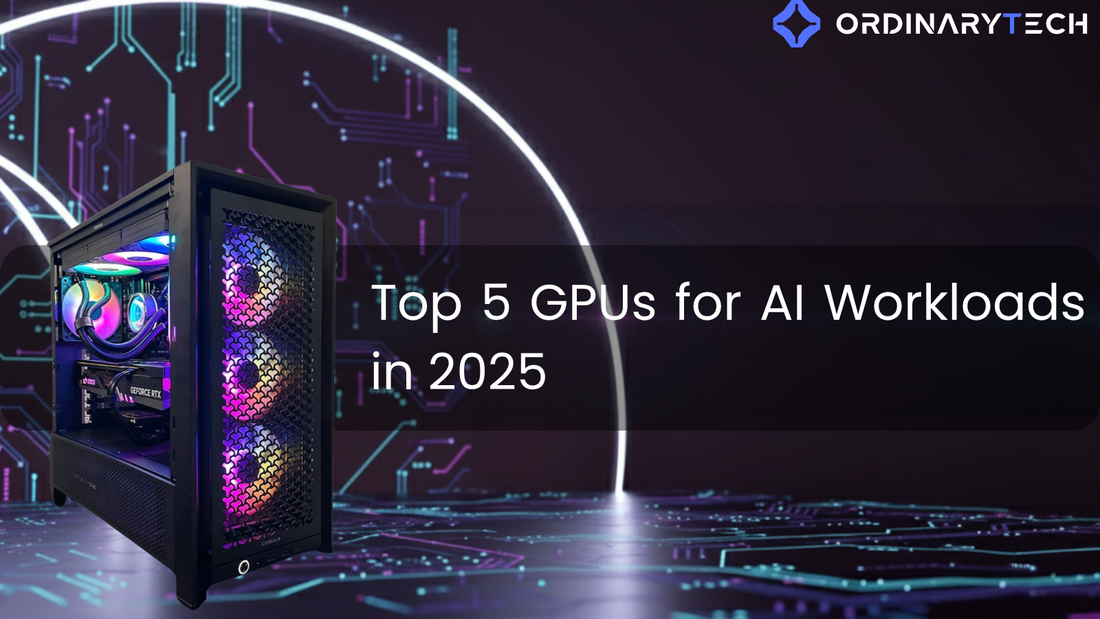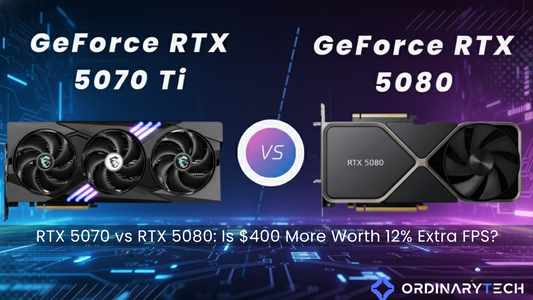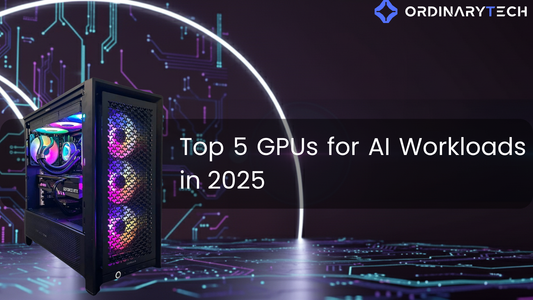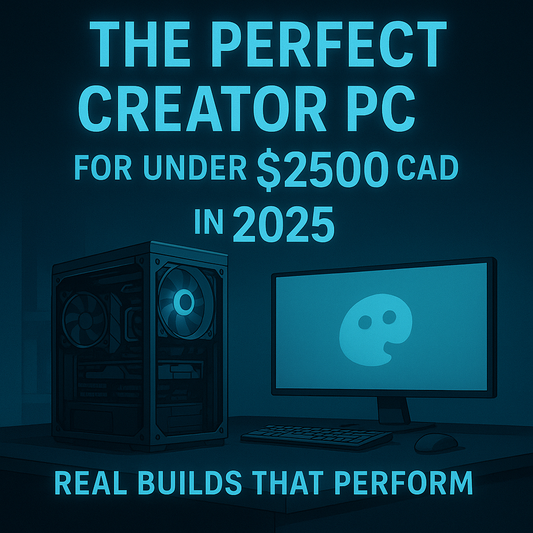
Top 5 GPUs for AI Workloads in 2025
Sadip RahmanShare
Best GPUs for AI Workloads in 2025: Performance Leaders and Smart Investments
The AI GPU market in 2025 has matured beyond simple CUDA core counts. Today's leading cards deliver specialized tensor architectures, massive memory pools reaching 192 GB, and purpose-built inference engines that handle everything from large language models to real-time image generation. After building hundreds of AI workstations this year, we've seen firsthand how the right GPU choice can cut training times by 70% or enable deployment of models previously impossible on local hardware.
Enterprise Powerhouses: H200 and MI300X Lead the Pack
NVIDIA's H200 Hopper represents the current pinnacle of AI acceleration, delivering 1.2 PFLOPS of FP8 performance paired with 141 GB of HBM3e memory. What makes this significant isn't just the raw numbers - it's the ability to keep entire foundation models in memory without constant swapping. We recently deployed an H200-based server for a Toronto fintech client running real-time fraud detection models, and they saw inference latency drop from 340ms to under 50ms compared to their previous A100 setup.
AMD's Instinct MI300X challenges NVIDIA's dominance with an impressive 192 GB of HBM3 memory - the highest available in any single GPU today. Running at 1.0 PFLOPS FP8 performance, it particularly shines when working with massive datasets that would require multiple GPUs from competitors. The ROCm 6.0 software stack has finally reached maturity, with major frameworks like PyTorch offering near-parity support compared to CUDA implementations.
Quick Win: If your models exceed 100 GB, the MI300X's memory advantage can eliminate the need for model parallelism, simplifying deployment and reducing overall system cost.
Workstation Champions: RTX 5090 and RTX 6000 Ada
The RTX 5090's Blackwell 2.0 architecture marks a generational leap for desktop AI development. With 21,760 CUDA cores and 680 fifth-generation tensor cores pushing 450 TFLOPS at FP16, this card handles serious AI workloads that previously required server-grade hardware. The 32 GB of GDDR7 memory runs at unprecedented speeds, effectively doubling the bandwidth available for shuttling data to those tensor cores.
What sets the RTX 5090 apart in practice is its versatility. A game developer in our network uses dual RTX 5090s to train custom style transfer models during the day and switches to Unreal Engine 5 development with Nanite and Lumen at night - both workflows running at peak efficiency. The card's new FP4 precision mode enables training larger models than ever possible on consumer hardware.
For professional workstations requiring ECC memory and certified drivers, the RTX 6000 Ada Generation remains the gold standard. Its 48 GB of GDDR6 ECC memory and 1,398 TFLOPS of FP8 compute make it ideal for medical imaging AI, architectural visualization with AI denoising, and production machine learning pipelines where data integrity is non-negotiable.
Emerging Players and Specialized Solutions
Intel's Gaudi 3 accelerator deserves attention for specific workloads, particularly computer vision tasks. With 1.5 PFLOPS of BF16 performance and optimized libraries for vision transformers, it offers compelling price-to-performance in scale-out deployments. We've seen impressive results in security camera AI processing farms where Gaudi 3 clusters handle real-time object detection across hundreds of video streams.
Google's TPU v5e remains cloud-exclusive but offers 140 TFLOPS BF16 for organizations comfortable with cloud-native workflows. The tight integration with TensorFlow and JAX makes it particularly effective for teams already invested in Google's ecosystem.
Memory Architecture: The Hidden Bottleneck
Raw compute tells only half the story in 2025. Memory bandwidth has become the critical constraint for large language models and diffusion networks. The shift from GDDR6X to GDDR7 in consumer cards and HBM3e in datacenter GPUs represents more than incremental improvement - it fundamentally changes what's possible with local AI deployment.
Consider a typical 70B parameter LLM: even with 4-bit quantization, you need approximately 35 GB just to load the model. Add batch processing, key-value caches, and activation storage, and you quickly exceed 48 GB. This explains why the H200's 141 GB and MI300X's 192 GB capacities command premium prices - they enable single-GPU deployment of models that would otherwise require complex multi-GPU orchestration.
Software Ecosystem and Real-World Performance
CUDA remains the default choice for most AI frameworks, with NVIDIA's software stack offering unmatched optimization for PyTorch, TensorFlow, and JAX. However, AMD's ROCm has made substantial strides, and Intel's oneAPI shows promise for mixed-precision workloads. The key is matching your GPU choice to your software requirements - a mismatch here can negate any hardware advantages.
Temperature management has become crucial with these power-hungry cards. The RTX 5090 pulls up to 450W under full tensor load, while the H200 can exceed 700W. Our custom builds now standard include 360mm liquid cooling for any AI-focused system to maintain boost clocks during extended training sessions.
"After upgrading from dual RTX 4090s to our new H200 server configuration, our transformer model training times dropped by 65%, but more importantly, we can now work with models that simply wouldn't fit before. The investment paid for itself in three months through reduced cloud compute costs." - Research lead at a Montreal AI startup
Investment Strategy for 2025
For businesses evaluating AI GPU investments, consider these deployment scenarios:
- Research and Development: RTX 5090 or dual RTX 6000 Ada for flexibility and local iteration
- Production Inference: H200 or MI300X for maximum throughput and memory capacity
- Mixed AI/Graphics Workloads: RTX 6000 Ada for certified drivers and ECC memory
- Budget-Conscious Teams: Previous-gen RTX 4090 or A6000 still offer excellent value
- Vision-Specific Applications: Intel Gaudi 3 for cost-effective scaling
Frequently Asked Questions
What's the minimum GPU memory needed for local LLM deployment in 2025?
For practical local LLM deployment, 24 GB represents the baseline for 7B parameter models with comfortable batch sizes. However, 48 GB or more enables working with 30B+ parameter models and production-ready inference setups. The RTX 5090's 32 GB hits a sweet spot for developers, while the RTX 6000 Ada's 48 GB handles most enterprise scenarios.
Should I wait for next-generation GPUs or buy now?
The current generation represents a mature platform with excellent software support. Unless NVIDIA's rumored B100 or AMD's MI350X announcements are imminent (expected late 2025), today's options offer immediate productivity gains. The rapid pace of AI model development means waiting often costs more in lost productivity than any potential hardware savings.
How do I choose between NVIDIA and AMD for AI workloads?
NVIDIA remains the safe choice for maximum compatibility and optimization. Choose AMD's MI300X when memory capacity is paramount and you have engineering resources to handle occasional framework quirks. Intel Gaudi makes sense for specialized vision pipelines where you control the entire stack.
Making the Right Choice for Your AI Future
The 2025 GPU landscape offers unprecedented capability for AI workloads, from desktop development to datacenter deployment. Success comes from matching hardware to specific requirements rather than chasing specifications. Consider memory needs first, evaluate software compatibility second, and factor in power and cooling infrastructure third.
At OrdinaryTech, we've configured hundreds of AI workstations and servers this year, helping teams navigate these exact decisions. Whether you need a single RTX 5090 development box or a multi-GPU H200 inference server, proper system integration makes the difference between theoretical and achieved performance.
Ready to accelerate your AI initiatives? Our team specializes in custom AI workstation builds optimized for your specific models and workflows. Book a free consultation to discuss your requirements, or browse our AI-ready workstation configurations designed for machine learning professionals.
Explore More at OrdinaryTech
- Explore OrdinaryAI - Our complete AI infrastructure solutions
- High-Performance Servers - Multi-GPU configurations for training and inference
- Custom PC Builds - Gaming and AI hybrid systems
Written by Sadip Rahman, Founder & Chief Architect at OrdinaryTech



